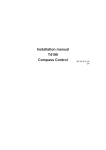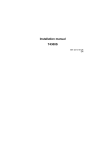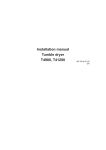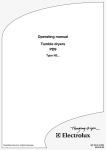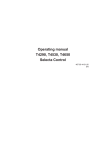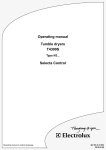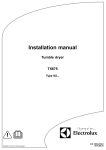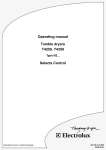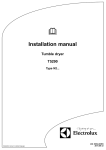Download Electrolux T4130 Installation manual
Transcript
Installation manual T4130 Compass Control 487 05 41 61.00 EN Safety instructions Safety instructions This machine is only intended for drying water-washed garments. Clothes that have been cleaned with chemicals/inflammable liquids, must NOT be dried in the machine. Remove clothes from the tumble dryer as soon as they are dry. This prevents them from becoming creased, and reduces the risk of spontaneous ignition. The machine must not be used for drying foam rubber or foamlike materials. The machine must not be used for drying floor mops*. The machine must not be used by minors. The machine must not be hosed down with water. Mechanical, electrical and gas installations must only be carried out by authorised personnel. If the machine has a fault, this must be reported as soon as possible to the person in charge. This is important for your own safety and for the safety of others. Gas dryers only: The machine is not to be installed in rooms containing cleaning machines with perchloroethylene, TRICHLOROETHYLENE or CHLOROFLUOROCONTAINING HYDROCARBONS as cleaning agents. What to do if you smell gas: Do not try to light any appliance. Do not touch any electrical switch; do not use any phone in your building. Evacuate the room, building or area. Contact the laundry manager. * Applies only to floor mops containing polypropylene. The dryer must not be installed behind a lockable door or a sliding door. In the rooms where the dryer is to be installed the door hinges must be on the outer side. 3 Contents Contents Technical data . . . . . . . . . . . . . . . . . . . . . . . . . . . . . . . . . . . . . . . . . . . . . . 6 Dimension sketch . . . . . . . . . . . . . . . . . . . . . . . . . . . . . . . . . . . . . . . . . . . 7 Unpacking . . . . . . . . . . . . . . . . . . . . . . . . . . . . . . . . . . . . . . . . . . . . . . . . . 8 Positioning . . . . . . . . . . . . . . . . . . . . . . . . . . . . . . . . . . . . . . . . . . . . 8 Mechanical installation. . . . . . . . . . . . . . . . . . . . . . . . . . . . . . . . . . . 8 Floor mounting. . . . . . . . . . . . . . . . . . . . . . . . . . . . . . . . . . . . . . . . . 8 Door reversal. . . . . . . . . . . . . . . . . . . . . . . . . . . . . . . . . . . . . . . . . . . . . . . 9 Installation on board a ship. . . . . . . . . . . . . . . . . . . . . . . . . . . . . . . . . . . 10 Washing column . . . . . . . . . . . . . . . . . . . . . . . . . . . . . . . . . . . . . . . . . . . 11 Condensate dryer . . . . . . . . . . . . . . . . . . . . . . . . . . . . . . . . . . . . . . . . . . 12 Installation of ventilating system . . . . . . . . . . . . . . . . . . . . . . . . . . 12 Changing over condensate dryers. . . . . . . . . . . . . . . . . . . . . . . . . 13 Evacuation system . . . . . . . . . . . . . . . . . . . . . . . . . . . . . . . . . . . . . . . . . 14 Air principle . . . . . . . . . . . . . . . . . . . . . . . . . . . . . . . . . . . . . . . . . . 14 Fresh air. . . . . . . . . . . . . . . . . . . . . . . . . . . . . . . . . . . . . . . . . . . . . 14 Exhaust duct . . . . . . . . . . . . . . . . . . . . . . . . . . . . . . . . . . . . . . . . . 15 Electric installation . . . . . . . . . . . . . . . . . . . . . . . . . . . . . . . . . . . . . . . . . 17 Function check. . . . . . . . . . . . . . . . . . . . . . . . . . . . . . . . . . . . . . . . . . . . . 18 The manufacturer reserves the right to modify design and material specifications without notice. 5 6 Technical data Technical data - T4130/4130C Drum volume Standard dryer Condensate dryer 130 liter 130 liter Weight: Netto 54 kg 57 kg Drum: Diameter Depth Revolutions G-factor 575 mm 500 mm 53 rpm 0.9 575 mm 500 mm 53 rpm 0.9 Capacity: 6 kg 6 kg Heat effect: 5,1 / 3,2 kW 3,0 kW 0,13 kW 2730 rpm 3330 rpm 0,20 kW 2730 rpm 3330 rpm Motor: Effect Revolutions 50 Hz Revolutions 60 Hz 260 m3/h Air consumption: Piping: Evacuation Condensation water Ø 100 1/2" hose to drain Pressure drop: Evacuation 50/60 Hz max. 60 Pa Sound pressure level: < 70 dB (A) < 70 dB (A) 7 Dimension sketch Dimension sketch 595 735 850 Ø 100 310 100 197 78 78 44 402 510 Connecting branch condensate dryers only fl 14 550 Exhaust duct standard dryers only 115 235 49 105 1260 500 8 Unpacking Unpacking 1 Unpack the dryer from the packaging. There are no transportation fittings. Release the dryer from the pallet by cutting the plastic ribbon. Positioning Fig Place the dryer in such a way that work can 1 be done as easily as possible by the user as well as the service technician. The door is reversible. The distance to the wall or other equipment behind the dryer should be min. 300 mm and the distance to the sides min. 70 mm (if the dryer is to be equipped with a coin box the width of the coin box must also be added). However, for the purpose of servicing the dryer there should be free access to the back of it. 2 The dryer can be positioned on a 55-litre washing machine to form a washing column. Mechanical installation Fig Adjust the dryer to ensure that it is horizontal 2 and stands firmly on all 4 feet. The max. height adjustment is 14 mm. Floor mounting Fig The dryer can be installed directly on the floor 3 and fastened by means of the accompanying cups A. 3 510 42,5 Alt. 1 15,5 564 15,5 Alt. 2 Alt. 1 122 A drilling plan is given in fig. 3 in the form of alternative 1 (from the rear) or 2 (from the side), depending on the space for mounting the rocker brackets B. 42,5 95 Fasten the cups by means of the screws. Alt. 2 B 375 A 47,5 500 47,5 133 133 Front Alt. 2 Alt. 1 402 Drill the rawlplug holes using a 10 mm drill. 9 Door reversal Door reversal 1. Disconnect the power supply to the dryer. 2. Loosen the hinge mounting and push it down to allow the door to be lifted off. Unscrew the hinge mounting. NB! Hold the door securely while loosening the screws. 3. Unscrew the cover screws at the opposite side and loosely mount the hinge mounting. Screw in the cover screws where the hinge was previously mounted. Lower pivot Upper pivot TOP 4. Remove the three black plugs at the top of the door. 5. Dismount the handle by loosening the three screws. 6. Remove the pivot at the top to the other side. 7. Mount the handle at the opposite side where the plugs used to be. 8. Insert the plugs where the handle used to be. 9. Remove the bottom pivot to the other side. 10. Release the locking plates by loosening the barb with a screwdriver. 11. Press out the locking plates, swap them over and press into position. A TOP 12. Mount the door. Push the hinge mounting upwards and tighten the screws. 13. Test the door (use washers to adjust the hinge if necessary). Check that door pin (A) is aligned with the microswitch aperture. 14. Connect the power to the dryer. Finally, check that the dryer stops when the door is opened. Installation on board a ship Installation on board a ship 28 12,5 573 Front 12,5 100 Drilling plan, see fig. 1. M8 416 Fig If the dryer is intended for installation on 1 board a ship, fittings are mounted from factory (instead of feet) on the dryer for attachment to the ship floor by means of 4 M8 bolts. 1 175 10 11 Washing column Washing column The dryer can be installed on top of a 55-litre washing machine WE455H or on a 130-litre dryer T4130(C). 1 The washer at the bottom must be levelled and rest on all four feet. A Fig • Place the frame on the top plate of the 1 lower machine, ensuring that the holes for the fastening bracket A are at the rear. • Screw the dryer feet of the upper machine all the way home to ensure that they do not touch the top plate of the lower machine. • Lift the dryer into position, thereby making sure that the machine fronts are flush. Fig • As a protection against tilting, the two 2 accompanying plate screws are to be inserted in either side in holes B. • If holes B are not provided in the side plates, drill them with a 3.3 mm drill. Note! If it is hard to read the display adjust the contrast in the service menu (see the programming manual supplied with the dryer. 2 B 12 Condensate dryer Condensate dryer 1 The condensate dryer does not have ventilation (evacuation) into the open. The air is circulated in a closed system between the dryer and condensing unit. The water in the garments condenses in the condensing unit. All the energy (3,4/2,4 kW) used for drying the garments ends up in the room in the form of heat. During operation, the room experiences a temperature increase, which results in a need for ventilation. The moisture ends up as water in the drains. Fig Note! The hose must be "sloping" 1 towards the drain and not form a water trap. Installation of ventilating system 2 For ventilation, a thermostatically controlled fan, type EQ 250, is used. It can be ordered as item no. 988 80 20 43. Fig The fan is to be placed on a 2 wall facing the outside behind the condensate dryer, while the thermostat is placed further into the room in an accessible place. The fresh air intake must end in the room in front of the dryer, positioned diagonally from the fan. Pressure drop max.: 10 Pa. The fresh air requirement per dryer is 750 m3/h (if the temperature is kept constant). The need for fresh air varies and is controlled by the thermostat. 13 Condensate dryers Changing over condensate dryers To be carried out by qualified personnel 3 x 400/415V + N 3,4kW 3 x 200/230/240V 3,4kW B1 B1 1 x 230/240V 3,4kW B1 Applies to all dryer types 14 Evacuation system Evacuation system 1 (does not apply to condensate dryers) Air principle A The ventilator creates low pressure in the dryer, drawing air into the drum via the heating unit. 5xA The heated air passes through the garments and the holes of the coarse filter. Then the air flows through a lint screen positioned in the door. After this, the air is evacuated through the fan and the evacuation system. It is very important that the dryer gets enough fresh air, see next section. Fresh air Fig For the machine to work optimally with the 1 shortest possible drying time, it is important for the air input to the room to come from an aperture from outside through which the same amount of air is taken into the room as is blown out. To avoid a draught in the room, the air inlet should preferably be placed behind the dryer. Fig The free area* of the air inlet aperture must be five times the area of the exhaust duct. 2 The resistance in the grating/slats should not exceed 10 Pa (0.1 mbar). The air consumption is approx. 260 m3/h. Note that grates/slatted openings often block half the total area of the fresh air intake. Remember to make allowance for this fact when dimensioning. * The free area is the area which the air can flow through without resistance from grate/ slatted opening. 2 5xA 15 Evacuation system Exhaust duct • The exhaust duct must be smooth on the inside (low air resistance). • The exhaust duct must lead to the outdoors. • The exhaust duct must lead clear of the building as condensation may cause frost damage to the building. • The exhaust duct must be protected against rain and foreign objects. Fig • The exhaust duct must have gentle bends. 1 • The exhaust duct must not be a shared duct between dryers and appliances using gas or other fuels as their energy source. When several dryers share an exhaust duct Fig • The exhaust duct diameter must increase after each dryer. 2 The table below shows the exhaust duct diameter and the necessary fresh-air inlet area. Note! It is recommended that each dryer is connected to a separate exhaust duct. The exhaust duct diameter must not be reduced. ** If the exhaust duct lenght exceeds 6 m the diameter must be increased. No. of dryers Exhaust m3/h d mm Fresh air inlet cm2 Exhaust duct lenght 0-6m d **Exhaust duct lenght 6-50m d 1 260 ø100 400 ø100 ø160 2 520 ø100 800 ø160 ø200 3 780 ø100 1200 ø200 ø250 4 1040 ø100 1600 ø250 ø350 16 Evacuation system Exhaust duct Gentle bends 1 Several dryers share an exhaust duct 2 17 Electric installation Electric installation To be carried out by qualified personnel The dryer must be given a fuse group of its own and switch in accordance with IEC 60947. For each dryer, a multi-pole permanent switch is to be placed in the permanent installation. It must be easily accessible, but there must be no mistaking it for the operating switch for the dryer. The motor features an integrated thermal fuse, which is why motor protection in the installation is unnecessary. Remove the top plate of the dryer to connect the cable. Install the dryer as a permanent installation. See dimensions in the table. Function check, see next page. The dryer must be equipped with supplementary protection in accordance with current regulations. External fan A connection terminal is available for controlling an external fan. Connection of external contactor (Does not apply to marine models) Cable dimensioning table Type Standard dryer Condensate dryer Voltage Ext. connection Max. 1,25A Powerintake Heating Fuse 400-440V 3N / 3 AC 5,3 kW 5,1 kW 10A 200-240V 3 AC 5,3 kW 5,1 kW 16A 230-240V 3 AC 3,4 kW 3,2 kW 10A 230-240V 1 AC 3,4 kW 3,2 kW 16A 400-440V 3N / 3 AC 3,4 kW 3,0 kW 10A 230-240V 3 AC 3,4 kW 3,0 kW 10A 230-240V 1 AC 3,4 kW 3,0 kW 16A 000-200V 3 AC 3,4 kW 3,0 kW 16A 18 Function check Function check To be carried out by qualified personnel Check whether the drum is empty and the door has been closed. Start the dryer Check whether the door lock is working: The drum must stop if the loading door is opened. Fig The dryer has a single phase motor, which 1 is why the direction of rotation (clockwise) is always correct. Marine version For dryers on board a ship (3-phase motor) the direction of rotation must be checked. If the direction of rotation is not correct, swop two phases on the connection terminal. Final test Let the dryer work for 5 minutes on a program that requires heat. Then check whether the heating is working by opening the front door and feel the heat. If the above tests-points are in order, the dryer is ready for use. Service organisation/dealer If deficiencies or errors are detected, please contact your local service organisation/dealer. 1 www.electrolux.com/professional Share more of our thinking at www.electrolux.com about | case studies | contact 0845 077 65 65 Home Laundry Equipment Ozone Laundry Systems Chemicals Services Special Offers Ex Rental Testimonials Contact Us





















